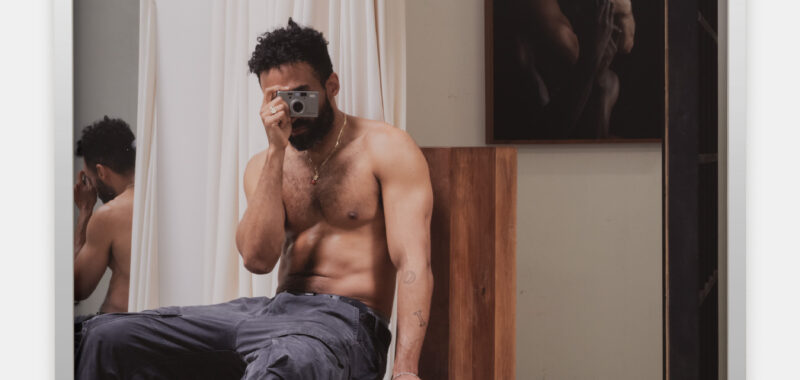Photography, in one conception, is the art of constructing fictions. Working with, alongside, and against conventions of portraiture photography, Paul Mpagi Sepuya manipulates the gaps between image and object. He creates, negotiates, and frustrates desire and intimacy — viewers glimpse fantasy, but never quite reach a state of full enjoyment of it. In TRANCE, his second solo show at Bortolami, the artist elevates this longstanding interest in toying with the medium of photography into a maze of repetition, seriality, and cross-referencing.
Two freestanding billboard structures, together entitled “Studio Mirror Diptych (_DSF3596, _DSF3598)” (all works 2024) dominate the entrance to the exhibition. But they face away from the viewer, denying easy access. A billboard is a public monument that traffics in commerce and consumption, therefore eliciting identification, yet here they are reoriented inward, suggesting introspection or intimacy. As we come around to the front, we see that these works capture the process of production: Older works are hung on walls beside studio equipment, acting as props. The artist himself is depicted but disembodied, split in half by the gap between the billboards with only the outer edges of his limbs visible. A mirror in the image confuses any deciphering of depth. It’s unclear what’s being documented by the artist’s camera, seen at the right edge of the leftward billboard — possibly us. The act of sitting for photography, traditionally a passive position, is here turned against itself: the positions of spectator and performer switch off, dissolving the fourth wall and complicating a linear sense of time in which a work is completed and then viewed.

Communicative efficacy is also thrown into chaos elsewhere in the exhibition. In “Night Studio Mirror (_ DSF1073),” we see the artist holding a piece of cloth in front of his torso, documenting himself, his viewer, or an unknown third subject via a camera on a tripod. But a tilted mirror in the background beside him coyly reveals the artist’s naked buttock, opening up a new pictorial plane as well as a space of desire. The artist, trying to cover up his nakedness, is betrayed by the mirror — or perhaps it was all intentional. If eroticism is the desire for the unseen, then the camera at his hip, with its phallic rod and knob, stokes that desire. This game is reprised in works like “Gallery Gazing Ball (DSCF1919)” in which a beautiful young man (a collaborator? a lover?) looks disaffectedly downward, as if evading representation, in front of what appears to be a reflective sphere. Here, the phallic rod holding up that ball threatens to obfuscate his mostly revealed penis, again playing with the eroticism of the seen and unseen.
Psychoanalysis figures the phallus as the thing that we desire but cannot have. In these photographic fictions, we sometimes feel that we’ve captured that object of desire — but only for an instant, before we realize we’ve fallen victim to Sepuya’s dazzling techniques of mirroring and misdirecting. The real thing, he reminds us, might not even be in the picture.


Paul Mpagi Sepuya: TRANCE continues at Bortolami (39 Walker Street, Tribeca, Manhattan) through March 1. The exhibition was organized by the gallery.

